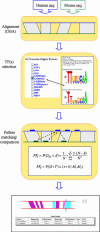FOOTER: a web tool for finding mammalian DNA regulatory regions using phylogenetic footprinting
- PMID: 15980508
- PMCID: PMC1160181
- DOI: 10.1093/nar/gki420
FOOTER: a web tool for finding mammalian DNA regulatory regions using phylogenetic footprinting
Abstract
FOOTER is a newly developed algorithm that analyzes homologous mammalian promoter sequences in order to identify transcriptional DNA regulatory 'signals'. FOOTER uses prior knowledge about the binding site preferences of the transcription factors (TFs) in the form of position-specific scoring matrices (PSSMs). The PSSM models are generated from known mammalian binding sites from the TRANSFAC database. In a test set of 72 confirmed binding sites (most of them not present in TRANSFAC) of 19 TFs, it exhibited 83% sensitivity and 72% specificity. FOOTER is accessible over the web at http://biodev.hgen.pitt.edu/Footer/.
Figures


Similar articles
-
CONREAL web server: identification and visualization of conserved transcription factor binding sites.Nucleic Acids Res. 2005 Jul 1;33(Web Server issue):W447-50. doi: 10.1093/nar/gki378. Nucleic Acids Res. 2005. PMID: 15980509 Free PMC article.
-
CONREAL: conserved regulatory elements anchored alignment algorithm for identification of transcription factor binding sites by phylogenetic footprinting.Genome Res. 2004 Jan;14(1):170-8. doi: 10.1101/gr.1642804. Epub 2003 Dec 12. Genome Res. 2004. PMID: 14672977 Free PMC article.
-
CREME: Cis-Regulatory Module Explorer for the human genome.Nucleic Acids Res. 2004 Jul 1;32(Web Server issue):W253-6. doi: 10.1093/nar/gkh385. Nucleic Acids Res. 2004. PMID: 15215390 Free PMC article.
-
Phylogenetic footprinting: a boost for microbial regulatory genomics.Protoplasma. 2012 Oct;249(4):901-7. doi: 10.1007/s00709-011-0351-9. Epub 2011 Nov 24. Protoplasma. 2012. PMID: 22113593 Review.
-
Evolution of transcriptional control in mammals.Curr Opin Genet Dev. 2009 Dec;19(6):579-85. doi: 10.1016/j.gde.2009.10.003. Epub 2009 Nov 11. Curr Opin Genet Dev. 2009. PMID: 19913406 Review.
Cited by
-
Profibrotic role of miR-154 in pulmonary fibrosis.Am J Respir Cell Mol Biol. 2012 Dec;47(6):879-87. doi: 10.1165/rcmb.2011-0377OC. Epub 2012 Oct 4. Am J Respir Cell Mol Biol. 2012. PMID: 23043088 Free PMC article.
-
PromAn: an integrated knowledge-based web server dedicated to promoter analysis.Nucleic Acids Res. 2006 Jul 1;34(Web Server issue):W578-83. doi: 10.1093/nar/gkl193. Nucleic Acids Res. 2006. PMID: 16845074 Free PMC article.
-
Deregulation of common genes by c-Myc and its direct target, MT-MC1.Proc Natl Acad Sci U S A. 2005 Dec 27;102(52):18968-73. doi: 10.1073/pnas.0507902102. Epub 2005 Dec 19. Proc Natl Acad Sci U S A. 2005. PMID: 16365299 Free PMC article.
-
Regulatory conservation of protein coding and microRNA genes in vertebrates: lessons from the opossum genome.Genome Biol. 2007;8(5):R84. doi: 10.1186/gb-2007-8-5-r84. Genome Biol. 2007. PMID: 17506886 Free PMC article.
-
The PAZAR database of gene regulatory information coupled to the ORCA toolkit for the study of regulatory sequences.Nucleic Acids Res. 2009 Jan;37(Database issue):D54-60. doi: 10.1093/nar/gkn783. Epub 2008 Oct 29. Nucleic Acids Res. 2009. PMID: 18971253 Free PMC article.
References
-
- Hughes J.D., Estep P.W., Tavazoie S., Church G.M. Computational identification of cis-regulatory elements associated with groups of functionally related genes in Saccharomyces cerevisiae. J. Mol. Biol. 2000;296:1205–1214. - PubMed
-
- Workman C.T., Stormo G.D. ANN-Spec: a method for discovering transcription factor binding sites with improved specificity. Pac. Symp. Biocomput. 2000:467–478. - PubMed
-
- Hertz G.Z., Hartzell G.W., III, Stormo G.D. Identification of consensus patterns in unaligned DNA sequences known to be functionally related. Comput. Appl. Biosci. 1990;6:81–92. - PubMed
-
- GuhaThakurta D., Stormo G.D. Identifying target sites for cooperatively binding factors. Bioinformatics. 2001;17:608–621. - PubMed
-
- Bailey T.L., Elkan C. The value of prior knowledge in discovering motifs with MEME. Proc. Int. Conf. Intell. Syst. Mol. Biol. 1995;3:21–29. - PubMed

